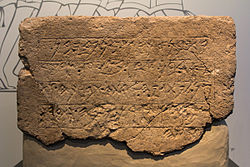Ekron Royal Dedicatory Inscription
| Ekron Inscription | |
|---|---|
 The inscription in its current location | |
| Material | Limestone |
| Size | H: 39; W: 60; D: 26 cm |
| Writing | Phoenician alphabet[1] |
| Created | first half of the 7th century BCE |
| Discovered | 1996 |
| Present location | Israel Museum |
| Identification | IAA 1997-2912 |
The Ekron Royal Dedicatory Inscription, or simply the Ekron inscription, is a royal dedication inscription found in its primary context[2] in the ruins of a temple during the 1996 excavations of Ekron.[3] It is known as KAI 286.
It is incised on a rectangular-shaped limestone block, has five lines and 71 characters,[1] and mentions Ekron, thus confirming the identification of the site, as well as five of its rulers, including Ikausu (Achish), son of Padi, who built the sanctuary. Padi and Ikausu are known as kings of Ekron from the late 8th- and 7th-century Neo-Assyrian Royal Annals.[4] King Padi is mentioned in connection to events from the years 701 and 699 BC, King Ikausu in relation to 673 and 667 BC, placing the date of the inscription firmly in the first half of the 7th century BC, and most likely in the second quarter of that century.[5]
It is the first connected body of text to be identified as "Philistine",[6] on the basis of Ekron's identification as a Philistine city in the Bible (see Joshua 13:3 and 1 Samuel 6:17). However, it is written in a Canaanite dialect similar to Phoenician and Old Byblian, such that its discoverers referred to it as "something of an enigma".[7][8]
Discovery[]
The inscription was discovered in the Albright Institute of Archaeological Research Tel Miqne excavations of Ekron led by Seymour Gitin and Trude Dothan.
The inscription is one of the primary documents for establishing the chronology of events relating to the end of the late biblical period, especially a possible late history of the Philistines.[9][10][11] The inscription has therefore been referred to as one of the most important archaeological finds of the 20th century in Israel.[12]
Translation[]
The text is written from right-to-left in the style and dialect of Phoenician inscriptions from Byblos.[13] It has been transcribed and translated as: